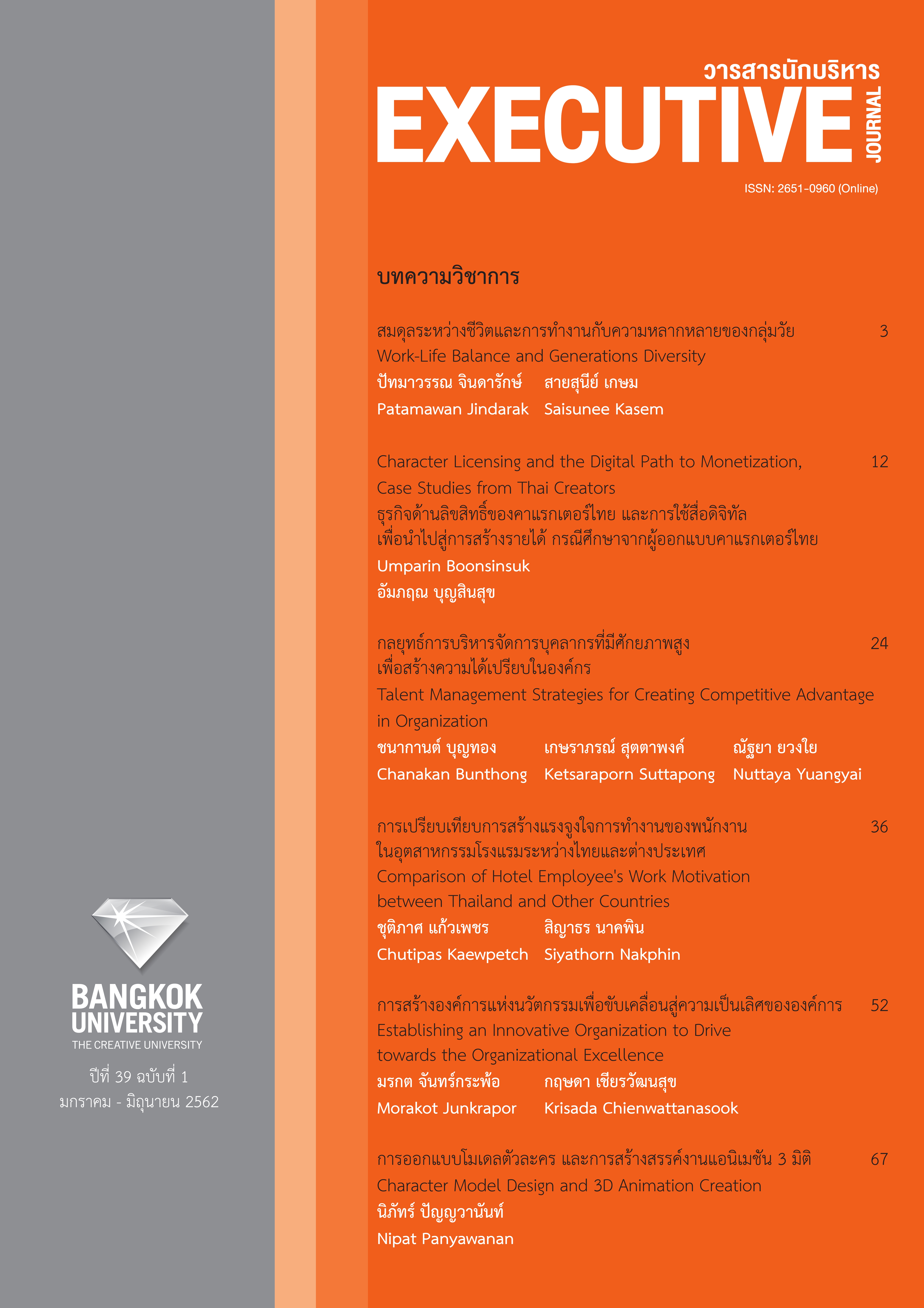Character Model Design and 3D Animation Creation
Main Article Content
Abstract
Animation creation refers to conveying the imagination of the director to the audience. There are many compositions in emotional media such as good chapters and stories with an effect on the storytelling. Moreover, various steps are included for animation or animation creation. Animation creators will study and practice various skills from modeling up, in which the creators have to design both characters and scenes. In terms of character characteristics, both facial and eye expressions will help convey emotions in order to promptly match the script or the story. Furthermore, the creators will study the habitual character of the characters, motion, and lighting for characters and scenes to create animation perfectly
The author studied the character design in Thailand, such as the animations, of the giant story, that brought the Ramayana story to be a robot. However, there are differences of characters in the matter of the main character size. In foreign countries, there is an animation about Wall.E that conveys the love between two robots that were different from each other by using geometry shapes to direct and clearly design different and interesting designs. The author wanted to be a part of bringing simple geometry shapes to convey for use in interesting animation works, as well as the role of applying geometry to create requirements for 3D character design for animation character patterns, gestures, emotions, habits, age, and character analysis that is consistent or conflicting, including the explanation of various steps in the work to come out as a complete 3D animation work.
Article Details
The manuscript submitted for publication must be the original version, submitted only to this particular journal with no prior acceptance for publication elsewhere in other academic journals. The manuscript must also not violate the copyright issue by means of plagiarism.
References
Anticipation. (n.d.). Retrieved November 5, 2018, from https://www.evl.uic.edu/ralph/508S99/anticipa.html
Aueragsakul, T. (2004). Kānsāng phāpphayon sō̜ng D ʻǣ ni mē chan [How to make 2D animation]. Bangkok: Media Intelligence Technology.
Autodesk Help. (2018). UVs products and versions covered. Retrieved March 2, 2019, from https://knowledge.autodesk.com/support/maya/learn-explore/caas/CloudHelp/cloudhelp/2018/ENU/Maya-Modeling/files/GUID-FDCD0C68-2496-4405-A785-3AA93E9A3B25-htm.html
Blue. (2014). Maya animation for parts. Retrieved March, 27, 2018, from https://forum.kerbalspaceprogram.com/index.php?/topic/81720-maya-animation-for-parts/
Campbell, N. (2010). The importance of compositing: A layer by layer breakdown in after effects. Retrieved March 2, 2019, from https://greyscalegorilla.com/tutorials/the-importance-of-compositing-a-layer-by-layer-breakdown-in-after-effects/
Funny macaw rigged 3D model. (2018). Retrieved March 20, 2018, from https://www.cadnav.com/3d-models/model-22766.html
Janma, V. (2004). Kānʻō̜kbǣp phāpphayon animation laksana Thai [Thai style animation design] (Master’s thesis, Silpakorn University).
Janma, V. (2017). Kānʻō̜kbǣp phāp khlư̄anwai bainā læ pākkhō̜ ngō̜ tūalakhō̜n ʻǣnimēchan [Facial and lip movement design for animation character]. Art and Architecture Journal, 9(2), 67-81.
Kān klāi sō̜ng [Khan Kluay 2]. (2009, March 2). Retrieved November 5, 2018, from https://www.sanook.com/movie/20559/
Kozlowski, K. (n.d.). Bulletstorm, creep high poly model. Retrieved January 3, 2017, from https://kozlowski.artstation.com/projects/56W8
Larking, A. (2007a). Topo larking-eye.jpg. Retrieved March 12, 2019, from https://wiki.polycount.com/w/images/c/c5/Topo_larking-eye.jpg
Larking, A. (2007b). Topo larking-mouth.jpg. Retrieved March 12, 2019, from https://wiki.polycount.com/w/images/5/5d/Topo_larking-mouth.jpg
Myers, S. (2016). Character archetypes: “Up”. Retrieved May 15, 2019, from https://gointothestory.blcklst.com/character-archetypes-up-19ee4f871a4a
Narklada, A. (2013). Thritsadī sī (ART112) (Phim khrang thī 9) [Theory of colour (ART112) (9th ed.)]. Bangkok: Rangsit University.
Niyomtum, S. (n.d.). Chittawitthayā hǣng sī [Color psychology]. Retrieved January 2, 2019, from https://rise.swu.ac.th/Portals/184/documents/articles/The_Psychology_of_Color.pdf
Noschenko, N. (2018). Nazar Noschenko topology.jpg. Retrieved March 12, 2019, from https://wiki.polycount.com/w/images/e/ed/Nazar_Noschenko_topology.jpg
Prachachit, K., Soodsang, N., Pirasant, J., & Pittungnapoo, W. (2014). Phon khō̜ng kātūn ʻǣ ni mē chan thī mī tō̜ kānraprū læ čhit nưk dān watthanatham khō̜ng chāo čhangwat sīsakēt [Effects of cartoon animation in perception and awareness towards cultures of Srisaket residents]. Art and Architecture Journal, 5(2), 42-58.
Pesopas, T. (2002). Kānʻō̜kbǣp tūalakhō̜n phư̄nthān samrap dek [Basic character design for the children]. Sripatum Chonburi Journal, 12(5), 181-189.
Pommerening, R., & Penkner, A. (2016). 3D low poly characters. Retrieved December 15, 2018, from https://www.behance.net/gallery/44657667/3D-Low-Poly-Characters
Roungsan, N. (2008). Sāng kātūn animation dūai Flash [Create cartoon animation with Flash]. Bangkok: Provision.
Sherman, A. (n.d.). Fan art Baymax character. Retrieved May 15, 2019, from https://albertsherman.artstation.com/projects/9oW3R
Spagnolo, F. (2014). Superman-character art design. Retrieved May 15, 2019, from https://dribbble.com/shots/1385131-Superman-Character-Art-Design
Steve. (2015). MDU115.1 research and development blog 3. Retrieved April 26, 2018, from https://stevenmorris.weebly.com/mdu1151-blog/mdu1151-research-and-development-blog-3
Suntiarpon, R., Kaewphakdee, K., Yunnan, M., & Chaotrakul, W. (2016). Kānʻō̜kbǣp khā ræktœ̄ satikkœ̄lai læ ʻǣnimēchan phayūn. In ʻēkkasān prakō̜p kān prachum radap chāt Narēsūan wičhai khrang thī sipsō̜ng læ nawattakam kap kānphatthanā prathēt [Character design, Line sticker and animation “Sea cow” In National conference Naresuan research 12th and innovation with national development] (pp. 1789-1797). Phitsanulok: Naresuan University.
Villar, O. (2014). Learning blender: A hands-on guide to creating 3D animated characters. Retrieved December 26, 2018, from https://www.oreilly.com/library/view/learning-blender-a/9780133886283/ch07lev2sec20.html

